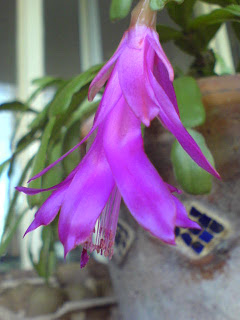For the first time ever, I've cut a warp off the loom without making something of it. The olive pleats in
this post were looking absolutely lovely - but the beautifully soft 30/2 merino I was using for the warp was far too soft to support any tension as a warp. It was stretching with every pick, and I was averaging a broken warp thread with every pick taken. It made for even slower weaving than the weak 60/2 silk warp and wasn't going to ever turn into a fabric that could be used. So with six inches or so woven, I called the result a sample and cut it off. I finished it, but appear not to have a photo of it. Set at 30 epi, the result is rolling pleats, but a slightly stiffer fabric than one would want to wear.
Not to waste the time I'd spent threading, I chose to tie on a warp I painted some time ago, intending to use for a pleated scarf. The warp is hand-painted NZ artisan lace-weight merino, a bit thicker than the merino I'd been using. I'd used this yarn before, for
the multi-coloured scarf so knew it would stand up to life on the loom. It's a bit thicker than the merino in the previous warp, so I resleyed at 24 epi.
The new warp had about 30 more ends than the previous one, so I wound up a short dummy warp in red cotton for each side, to add the extra ends:

Having wound the warp prior to painting on my warping mill, I had a cross tied into each end. I put the threading cross through lease sticks, and tied these to the breast beam of the loom.

You can see my beloved trusty steed in the background. She lives in the studio with me and gives me immense pleasure on the 9-mile commute to and from work.

Tying each thread to the previous warp, I beamed the warp on. You can see in the image above how stretchy the previous olive green warp was: when I tied on, all the warp threads had been cut to the same length. By the time the knots had been eased through the reed and heddles, the wool warp was overall more stretched than the cotton, and some sections of it had stretched more than others. This has had the advantage of giving an attractive chevroning along the warp but may cause problems with tension once I get to the end of the warp. That won't be a problem for the scarf this will turn into, because there's enough length in the warp for the tail end to be samples. I can experiment.
I use the 'water jug' method of tensioning when beaming a warp this way: I tie the warp into a loose overhand knot, and hang over it a half-litre jug of water to weight it. I only beam a few inches at a time, stopping to shake and twang the warp threads into place for the next bit to pass through the reed - never combing my fingers through the warp. That just causes knots.

One the warp was beamed, I lashed the warp on. I always lash my warps on, I find it so much easier to get the warp to tension. I wind the lashing cord on a plastic bobbin, lash the warp on at a relatively easy, loose-to-medium tension, and then run my hands over the lashing cord to even the tension out. I continue to do this, increasing the tension one or two clicks of the ratchet at a time, running my hands over the lashing cord several times with each increase of tension. I find this gives me an even tension across the warp every time with no problems. If I'm not impatient, I'll often try to finish a day with a tensioned warp so I can let it rest overnight and settle before starting weaving in the morning. It means I spend many Friday nights tying up treadles!

More on the weaving tomorrow...



















